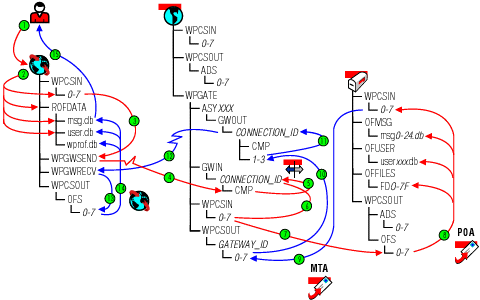Modem Link to the Remote User through the Async Gateway
This message flow diagram illustrates how a GroupWise Remote user can access the master GroupWise system through the GroupWise Async Gateway.

| Stage | Icon | Description |
|---|---|---|
|
|
The GroupWise user, who is not currently connected to the network, sends a message to another GroupWise user or creates a request for items from the master mailbox. This message flow diagram illustrates only the simplest case where the recipient is in the same post office as the GroupWise Remote user's master mailbox. If the GroupWise Remote user sends a message to a user in any other post office, the MTA would route the message to the appropriate destination. |
|
|
When the GroupWise Remote user sends a message to another GroupWise user, GroupWise Remote performs the following actions:
When the GroupWise Remote user sends a request for items from the master mailbox, GroupWise Remote places the request in the WPCSIN\1 subdirectory of the remote input queue on the user's remote computer. |
|
|
When the user initiates the modem connection, the GroupWise client on the remote computer polls the wpcsin\1 subdirectory and compresses the outgoing messages and/or requests into a file. If the compressed file totals over 50 KB, additional compressed files are created. The GroupWise client next moves the compressed files into the wpgwsend directory, then dials in to the gateway and logs in. |
|
|
After the login process is completed, GroupWise Remote transmits the compressed message/request file(s) across the modem connection to the system where the user's master mailbox is located. |
|
|
The GroupWise Async Gateway picks up the message/request files and decompresses them. |
|
|
The Async Gateway moves the message/request files to the MTA input queue. |
|
|
For mapped and UNC links, the MTA for the GroupWise Remote user's domain scans its input queue for messages to process. You can control the rate at which the MTA scans its input queues. See "Adjusting MTA Polling of Input Queues in the Domain and Post Offices" in "Message Transfer Agent" in the GroupWise 6.5 Administration Guide. When it detects the new message or request from the GroupWise Remote user, the MTA picks it up from its domain input queue and transfers it to its output queue in the post office where the GroupWise Remote user's master mailbox is located. The MTA output queue is the input queue for the POA in the post office where the GroupWise Remote user's master mailbox is located. This message flow diagram illustrates only the simplest case where the recipient is in the same post office as the GroupWise Remote user's master mailbox. If the GroupWise Remote user sends a message to a user in any other post office, the MTA would route the message to the appropriate destination. |
|
|
The POA polls its input queue regularly. It quickly detects the new message or request from the GroupWise Remote user. When the GroupWise Remote user sends a message, the POA performs the following actions:
When the GroupWise Remote user sends a request for items from the master mailbox, GroupWise Remote performs the following actions:
|
|
|
When the MTA in the GroupWise Remote user's domain detects the response for the GroupWise Remote user, the MTA picks it up from its post office input queue and transfers it to its output queue in the Async Gateway directory under wpgate in the GroupWise Remote user's domain. The MTA output queue in the Async Gateway directory is the input queue for the Async Gateway. |
|
|
The Async Gateway picks up the response file and moves it to the priority 1 subdirectory of its output queue. |
|
|
If the connection to the GroupWise Remote user is still active, the Async Gateway compresses the response files and moves them to the CMP directory. If the connection is no longer available, the response files wait in the connection_id\1 subdirectory until a new connection is established by the GroupWise Remote user. |
|
|
The Async Gateway transmits the response files through the modem connection to GroupWise Remote on the remote computer. |
|
|
The GroupWise client on the remote computer decompresses the response files and places them in its input queue on the GroupWise Remote user's computer. |
|
|
Taking the items from its input queue, the GroupWise client performs the following actions for the GroupWise Remote user:
The user's Remote mailbox now contains current copies of requested items from the user's master mailbox, plus any messages received in the user's master mailbox from other GroupWise users. |
|
|
The GroupWise user can now review current GroupWise mail when the connection to the master GroupWise system is no longer available. |





 :
: 












